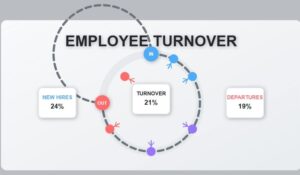Creating a workplace where employees truly want to be isn’t just nice to have anymore, it’s essential for business success. Employee satisfaction has become the cornerstone of high-performing organizations worldwide. When your workforce feels content, valued, and engaged, everything else falls into place naturally.
But here’s what many leaders get wrong: they confuse employee satisfaction with engagement. While these concepts are related, employee satisfaction refers specifically to how happy and fulfilled your team members feel about their jobs, work environment, and overall experience at your company. It’s about creating conditions where people genuinely enjoy coming to work every day.
In today’s competitive talent market, companies that prioritize employee satisfaction see remarkable results. They experience lower turnover rates, higher productivity levels, and stronger customer relationships. Most importantly, they build cultures where innovation thrives and teams consistently deliver exceptional results.
Why Employee Satisfaction Matters More Than Ever Before
The modern workplace has transformed dramatically over the past few years. Organizations must stay current with employee engagement trends to understand how these workplace changes impact satisfaction levels. Remote work, hybrid schedules, and changing employee expectations have reshaped what satisfaction looks like. Today’s professionals want more than just a paycheck – they seek purpose, flexibility, and genuine connection with their work.
Employee satisfaction refers to how happy and fulfilled an employee is at their job. A satisfied employee is content with their role and their work-life balance, often being more punctual, productive, and engaged as a result. This contentment creates a ripple effect throughout your entire organization.
Consider these compelling statistics: Organizations with highly satisfied employees report 31% higher productivity, 37% better sales performance, and 3x higher customer satisfaction scores. Additionally, companies focusing on employee satisfaction see 40% lower turnover rates compared to their competitors.
The financial impact speaks volumes too. Replacing a single employee can cost anywhere from 50% to 200% of their annual salary when you factor in recruiting, training, and lost productivity. Meanwhile, satisfied employees become your best ambassadors, referring quality candidates and reducing your hiring costs significantly.
The Real Cost of Ignoring Employee Satisfaction
When organizations neglect employee satisfaction, the consequences extend far beyond individual unhappiness. Many of these issues stem from common employee engagement mistakes that leaders make when trying to boost morale without addressing underlying satisfaction factors. Dissatisfied employees are more likely to call in sick, miss deadlines, and provide subpar customer service. They also spread negativity throughout teams, creating toxic environments that drive away top performers.
Furthermore, unsatisfied teams show decreased creativity and innovation. They stick to the bare minimum requirements rather than going above and beyond. This mediocrity becomes embedded in your company culture, making it increasingly difficult to attract and retain high-quality talent.
Understanding the Core Elements of Employee Satisfaction
Employee satisfaction encompasses several interconnected factors that work together to create positive workplace experiences. Unlike engagement, which focuses on emotional investment, satisfaction centers on contentment with specific job aspects and working conditions.
Work-Life Balance: The Foundation of Modern Satisfaction
Today’s professionals prioritize balance more than ever before. They want roles that allow them to excel professionally while maintaining personal relationships and pursuing outside interests. Companies that offer flexible schedules, remote work options, and respect for boundaries consistently report higher satisfaction scores.
Work-life balance isn’t just about hours, it’s about energy management. Employees need to feel they can bring their best selves to work without sacrificing everything else that matters to them. This means creating reasonable workloads, setting realistic expectations, and supporting time off when needed. Learn more about creating effective employee engagement strategies that support work-life balance.
Compensation and Benefits: Beyond the Paycheck
While money isn’t everything, fair compensation remains crucial for employee satisfaction. However, modern benefits packages extend far beyond salary. Health insurance, retirement plans, professional development opportunities, and wellness programs all contribute to overall satisfaction levels.
The key is creating comprehensive packages that address diverse employee needs. Some team members value additional vacation time, while others prefer educational reimbursements or flexible spending accounts. Understanding your workforce demographics helps you design benefits that truly matter to your people.
Career Development: Fueling Long-Term Satisfaction
Employees want to see clear paths for growth within your organization. This includes both vertical advancement opportunities and lateral moves that expand their skill sets. Regular performance reviews, mentorship programs, and training initiatives show your commitment to their professional development.
Career development also means providing challenges that stretch employees’ capabilities without overwhelming them. People find satisfaction in mastering new skills and taking on increased responsibilities. When you invest in their growth, they invest more deeply in your company’s success. Effective internal communication plays a crucial role in conveying growth opportunities and career pathways.
The Psychology Behind Employee Satisfaction
Understanding what drives satisfaction requires examining the psychological needs that work fulfills. Beyond financial security, employment provides identity, social connection, and personal fulfillment. When these deeper needs are met, satisfaction naturally follows. Research from Harvard Business Review shows that emotional fulfillment at work significantly impacts overall job satisfaction.
The Role of Recognition and Appreciation
Recognition is one of the most powerful drivers of employee satisfaction. People need to know their contributions matter and that leadership notices their efforts. This doesn’t always require grand gestures, consistent acknowledgment of good work often proves more effective than occasional major rewards.
Recognition programs work best when they’re timely, specific, and meaningful. Instead of generic “good job” comments, effective recognition highlights exactly what the person did well and why it mattered to the team or organization. This specificity makes the praise feel genuine and valuable.
Autonomy: The Freedom to Excel
Micromanagement kills satisfaction faster than almost anything else. Employees want the freedom to determine how they accomplish their goals, as long as they meet established standards and deadlines. This autonomy shows trust and respect for their professional judgment.
Autonomy doesn’t mean abandoning oversight entirely. Rather, it involves setting clear expectations and providing necessary resources, then stepping back to let people work. Regular check-ins and support remain important, but they should feel collaborative rather than controlling.
Purpose and Meaning: Connecting Work to Values
Satisfied employees understand how their daily tasks contribute to larger organizational goals. They see the impact of their work on customers, colleagues, and communities. This sense of purpose transforms routine tasks into meaningful contributions.
Creating purpose requires clear communication about company mission and values, plus regular reminders of how individual roles support these broader objectives. Share customer success stories, highlight team achievements, and connect daily work to positive outcomes whenever possible. Employee recognition programs can effectively reinforce this sense of purpose and meaning.
Building a Framework for Employee Satisfaction Success
Creating lasting employee satisfaction requires systematic approach rather than random initiatives. The most successful organizations develop comprehensive frameworks that address satisfaction from multiple angles simultaneously. Strategic employee engagement in HR requires systematic approaches that integrate satisfaction initiatives with broader talent management goals.
Assessment: Understanding Your Starting Point
Before implementing changes, you need accurate data about current satisfaction levels. Anonymous surveys provide valuable insights, but they’re just one piece of the puzzle. Focus groups, one-on-one conversations, and exit interviews offer additional perspectives on what’s working and what isn’t.
Regular pulse surveys help you track satisfaction trends over time. Short, frequent check-ins often prove more useful than lengthy annual surveys because they capture real-time sentiment and enable quick responses to emerging issues.
The key is asking the right questions. Instead of generic satisfaction ratings, probe specific areas like workload, communication, growth opportunities, and management support. This specificity helps you identify exactly where to focus improvement efforts.
Communication: The Cornerstone of Satisfaction
Transparent, consistent communication forms the backbone of employee satisfaction. Team members want to understand company direction, their role in achieving goals, and how decisions affect them personally. When communication breaks down, satisfaction inevitably suffers.
Effective communication flows in multiple directions. Leaders must share vision and updates clearly, but they also need to listen actively to employee concerns and feedback. Creating multiple communication channels ensures everyone can participate in ways that feel comfortable to them. Modern workforce communication becomes even more critical when managing distributed or deskless teams.
Regular team meetings, company-wide updates, and informal check-ins all play important roles. However, the quality of communication matters more than quantity. Focus on delivering clear, honest messages that respect employees’ intelligence and time.
Leadership Development: Managers Make the Difference
Direct supervisors have enormous impact on employee satisfaction. People don’t usually quit companies, they quit bad managers. Investing in leadership development pays dividends in improved satisfaction scores and reduced turnover.
Effective managers understand that their job involves supporting their team’s success rather than simply directing tasks. They provide regular feedback, remove obstacles, and advocate for their people within the organization. These behaviors create environments where satisfaction naturally flourishes.
Management training should cover both technical skills and emotional intelligence. Topics like active listening, conflict resolution, and performance coaching directly impact team satisfaction. Additionally, managers need tools and authority to address satisfaction issues quickly when they arise. Studies from MIT Sloan consistently show that management quality is the primary factor in employee retention decisions.
Implementing Employee Satisfaction Strategies That Work
Theory only matters if you can translate it into action. The most successful employee satisfaction initiatives combine multiple strategies that reinforce each other over time.
Creating Positive Work Environments
Physical and cultural environments significantly influence satisfaction levels. While you can’t please everyone, you can create spaces that support productivity, collaboration, and well-being. This includes both office design and remote work support.
Consider factors like noise levels, lighting, temperature, and available technology. Comfortable, functional workspaces help people perform their best while reducing daily frustrations. For remote teams, ensure they have necessary equipment and reliable internet connections.
Cultural environment matters even more than physical space. This includes everything from dress codes to meeting styles to decision-making processes. Cultures that emphasize respect, inclusion, and psychological safety consistently achieve higher satisfaction scores.
Flexible Work Arrangements: Meeting Modern Expectations
Flexibility has become non-negotiable for many employees. This might include remote work options, flexible hours, compressed work weeks, or job sharing arrangements. The specific options matter less than demonstrating trust in your team’s professionalism.
Successful flexibility requires clear expectations and communication protocols. Everyone needs to understand when they must be available, how to stay connected with teammates, and what constitutes acceptable response times. Without these guidelines, flexibility can create confusion and resentment. Remote work best practices from McKinsey provide excellent frameworks for maintaining satisfaction in flexible work environments.
Remember that flexibility looks different across roles and industries. Customer service representatives might need specific coverage hours, while project managers might have more schedule freedom. Tailor your approach to match both business needs and employee preferences.
Recognition Programs: Celebrating Success Together
Well-designed recognition programs significantly improve employee satisfaction when implemented thoughtfully. The best programs combine formal and informal recognition opportunities while ensuring all team members can participate as both givers and receivers.
Peer-to-peer recognition often proves more meaningful than top-down acknowledgment alone. When teammates celebrate each other’s successes, it builds stronger relationships and creates positive team dynamics. Technology platforms can facilitate this type of recognition while tracking participation patterns.
Recognition should align with company values and desired behaviors. If you want to encourage collaboration, recognize team achievements alongside individual accomplishments. If innovation is important, celebrate creative problem-solving and calculated risk-taking.
Technology Solutions for Employee Satisfaction Management
Modern technology offers powerful tools for measuring, tracking, and improving employee satisfaction. However, technology should support human connections rather than replace them entirely.
Employee Feedback Platforms
Digital platforms make it easier to collect regular feedback through pulse surveys, suggestion boxes, and anonymous reporting systems. The best platforms provide real-time analytics that help leaders identify trends and respond quickly to concerns.
Look for solutions that integrate with existing HR systems and provide mobile access for all employees. User-friendly interfaces encourage participation, while robust analytics help you understand what the data means for your organization.
Communication and Collaboration Tools
Internal communication platforms help teams stay connected and informed regardless of their physical location. Features like company news feeds, department updates, and social recognition walls create virtual water cooler conversations that build relationships.
Choose tools that fit your company culture and technical capabilities. Over-complicated systems create frustration rather than satisfaction. The goal is seamless communication that feels natural rather than forced.
Performance Management Systems
Modern performance management focuses on ongoing development rather than annual reviews. Digital platforms can facilitate regular check-ins, goal tracking, and feedback exchanges that support continuous improvement.
These systems work best when they feel collaborative rather than evaluative. Employees should be able to track their own progress, request feedback, and identify development opportunities without waiting for formal review cycles.
Measuring Employee Satisfaction Effectively
You can’t improve what you don’t measure, but measuring employee satisfaction requires more nuance than simple survey scores might suggest.
Key Metrics That Matter
Employee satisfaction metrics should reflect both current state and future trends. Traditional measures like satisfaction scores and retention rates provide important baselines, but leading indicators help you identify issues before they become major problems.
Consider tracking metrics like internal promotion rates, employee referral numbers, and participation in voluntary company activities. These behaviors often indicate satisfaction levels more accurately than survey responses alone.
Employee Net Promoter Score (eNPS) asks how likely team members are to recommend your company as a place to work. This single question captures overall satisfaction and predicts future retention better than many complex surveys. Research from Bain & Company shows that eNPS strongly correlates with business performance outcomes.
Regular Pulse Surveys vs. Annual Reviews
Pulse surveys provide frequent snapshots of employee sentiment, allowing you to identify and address issues quickly. Monthly or quarterly check-ins work better than annual surveys for most organizations because they enable timely responses.
Keep pulse surveys short and focused on specific topics. Rotate through different themes like communication, workload, management support, and career development. This approach provides comprehensive coverage without survey fatigue.
Always share survey results and action plans with your team. Employees need to see that their feedback creates real changes, or they’ll stop participating in future surveys.
Exit Interview Insights
Exit interviews reveal satisfaction issues that current employees might hesitate to share. While it’s too late to retain departing team members, their insights can prevent similar departures in the future.
Conduct exit interviews with neutral parties when possible. HR representatives or external consultants often receive more honest feedback than direct supervisors. Focus on systemic issues rather than personality conflicts to identify actionable improvement opportunities.
Common Employee Satisfaction Challenges and Solutions
Every organization faces unique satisfaction challenges, but several patterns appear consistently across industries and company sizes.
Remote Work Satisfaction Issues
Remote and hybrid work arrangements create new satisfaction challenges around isolation, communication, and work-life boundaries. Team members might feel disconnected from colleagues or struggle with home office distractions.
Solutions include regular virtual team building activities, clear communication protocols, and stipends for home office equipment. Additionally, respect boundaries around after-hours communication to prevent remote work from becoming always-on work. HubEngage’s mobile platform specifically addresses remote worker engagement challenges with features designed for distributed teams.
Career Development Concerns
Limited growth opportunities consistently rank among the top satisfaction concerns. Employees want to see clear paths forward, even in flat organizational structures.
Create development opportunities through cross-training, special projects, and external education programs. Not every path leads to promotion, but all should lead to increased skills and responsibility. Lateral moves can be just as satisfying as upward moves when positioned correctly.
Communication Breakdowns
Poor communication destroys satisfaction faster than almost any other factor. Team members feel frustrated when they lack information needed to do their jobs effectively or when they feel excluded from important decisions.
Implement regular communication rhythms that ensure information flows consistently throughout your organization. This might include weekly team updates, monthly all-hands meetings, and quarterly strategic reviews. The key is predictability and transparency.
Workload and Stress Management
Overwhelming workloads lead to burnout and decreased satisfaction. However, employees also feel dissatisfied when their work lacks challenge or purpose. Finding the right balance requires ongoing attention and adjustment.
Regular workload assessments help identify imbalances before they become critical. Encourage open conversations about capacity and priorities. Sometimes satisfaction issues stem from unclear expectations rather than excessive work volume.
Industry-Specific Employee Satisfaction Considerations
Different industries face unique satisfaction challenges that require tailored approaches.
Healthcare and High-Stress Industries
Healthcare workers, first responders, and others in high-stress roles face unique satisfaction challenges related to emotional demands and irregular schedules. Building resilience in the workplace becomes crucial for maintaining satisfaction in these demanding environments. Wellness programs, mental health support, and adequate staffing become crucial for satisfaction.
These industries often require 24/7 coverage, making traditional flexibility difficult. However, you can still offer schedule preferences, adequate rest between shifts, and support for maintaining certifications and continuing education.
Technology and Creative Fields
Tech and creative professionals often prioritize intellectual challenges, cutting-edge tools, and collaborative environments. Satisfaction in these fields might depend more on project variety and learning opportunities than traditional benefits.
Consider offering conference attendance, certification programs, and time for personal projects. Many tech workers value stock options or profit-sharing arrangements that align their success with company performance.
Manufacturing and Service Industries
Front-line workers in manufacturing and service industries face different satisfaction drivers than office-based employees. Safety, fair scheduling, and respect from management often matter more than perks like free snacks or ping-pong tables.
Focus on creating safe, clean work environments with reliable equipment. Clear advancement paths and cross-training opportunities show investment in worker development. Recognition programs should acknowledge both safety achievements and productivity improvements.
The Role of Company Culture in Employee Satisfaction
Company culture serves as the foundation for all satisfaction initiatives. Without a supportive culture, even well-intentioned programs can feel hollow or manipulative.
Building Inclusive Cultures
Inclusive cultures where all employees feel valued and respected naturally generate higher satisfaction scores. This requires more than policy statements, it demands consistent actions that demonstrate commitment to diversity and inclusion.
Train managers to recognize and address unconscious bias. Create employee resource groups that provide support and networking opportunities. Ensure that promotion and development opportunities are available to all qualified candidates regardless of background.
Values-Based Decision Making
When company actions align with stated values, employees feel more satisfied with their workplace. Conversely, when leaders say one thing but do another, satisfaction plummets quickly.
Involve employees in defining company values rather than imposing them from the top. Then consistently reference these values when making decisions, especially difficult ones. This consistency builds trust and satisfaction over time.
Psychological Safety
Psychological safety, the belief that you can speak up without risk of punishment or humiliation, is essential for satisfaction. Employees need to feel safe sharing ideas, reporting problems, and making mistakes without fear of retaliation.
Leaders must model vulnerability and admit their own mistakes to create psychologically safe environments. Respond to problems with curiosity rather than blame. Focus on system improvements rather than individual punishment when issues arise.
HubEngage: Your Partner in Employee Satisfaction Success
While understanding employee satisfaction principles is important, implementation often requires specialized tools and expertise. This is where HubEngage becomes your strategic advantage.
HubEngage offers a comprehensive platform specifically designed to improve employee satisfaction through better communication, recognition, and engagement. Unlike generic solutions, HubEngage understands the unique challenges facing modern workplaces and provides targeted tools to address them. Schedule a demo to see how our platform transforms employee satisfaction in organizations of all sizes.
Streamlined Communication for Better Satisfaction
HubEngage’s communication features ensure that every team member stays informed and connected, regardless of their location or schedule. Push notifications, targeted messaging, and interactive content delivery help prevent the communication breakdowns that destroy satisfaction.
The platform’s mobile-first design means field workers, remote employees, and office-based teams all have equal access to important information. This democratized communication creates more inclusive environments where everyone feels valued and informed.
Recognition That Drives Satisfaction
The platform’s recognition features make it easy to celebrate achievements and milestones that matter to your team. Peer-to-peer recognition, leadership acknowledgments, and milestone celebrations all contribute to higher satisfaction scores.
HubEngage’s recognition tools integrate seamlessly with your existing workflows, making appreciation a natural part of daily operations rather than an additional burden on managers and HR teams.
Data-Driven Satisfaction Insights
HubEngage provides detailed analytics that help you understand what drives satisfaction in your specific organization. Real-time dashboards track engagement with different content types, participation in recognition programs, and overall platform usage patterns.
These insights enable proactive satisfaction management rather than reactive responses to problems. You can identify trends early and adjust your approach before satisfaction issues become retention problems.
Mobile-First Employee Experience
Today’s workforce expects mobile-friendly solutions that work seamlessly across devices. HubEngage’s mobile platform ensures all employees can participate fully in company communications and programs, regardless of their work environment.
Mobile accessibility is particularly crucial for field workers, retail employees, and others who don’t spend their days at desks. When these team members feel connected and informed, overall satisfaction scores improve significantly.
Implementing Your Employee Satisfaction Strategy
Creating lasting improvements in employee satisfaction requires systematic implementation with clear timelines and accountability measures.
Phase 1: Assessment and Planning
Begin by establishing baseline satisfaction levels through surveys, interviews, and data analysis. Identify your biggest challenges and most significant opportunities for improvement. This assessment phase typically takes 4-6 weeks but provides crucial foundation for all subsequent efforts.
Involve employees in the planning process to ensure your initiatives address real concerns rather than perceived problems. Focus groups and advisory committees provide valuable input while demonstrating your commitment to employee-driven solutions.
Phase 2: Foundation Building
Start with fundamental improvements that address basic satisfaction drivers like communication, recognition, and management support. These foundational changes create positive momentum while preparing your organization for more advanced initiatives.
This phase might include management training, communication platform implementation, and basic recognition program launch. Allow 3-4 months for these foundational elements to take root before adding additional complexity.
Phase 3: Advanced Programs
Once basic satisfaction drivers are addressed, you can implement more sophisticated programs like career development pathways, flexible work arrangements, and comprehensive wellness initiatives.
These advanced programs require strong foundations to succeed. Rushing into complex initiatives without addressing fundamental issues often leads to failure and employee cynicism about satisfaction efforts.
Phase 4: Continuous Improvement
Employee satisfaction is not a destination but an ongoing journey. Regular measurement, feedback collection, and program adjustments ensure your initiatives remain effective as your workforce and business needs evolve.
Quarterly reviews and annual strategic planning sessions help you stay responsive to changing satisfaction drivers while maintaining momentum on existing successful programs.
Measuring ROI of Employee Satisfaction Investments
Investing in employee satisfaction requires resources, and leadership rightfully expects to see returns on these investments. Understanding employee engagement ROI helps justify satisfaction initiatives and demonstrates their business impact.
Direct Financial Benefits
Satisfied employees cost less to retain, require less management oversight, and generate higher productivity levels. Calculate these savings by comparing turnover costs, management time allocation, and output metrics before and after satisfaction improvements.
Additionally, satisfied employees provide better customer service, leading to higher customer retention rates and increased revenue. These customer experience improvements often provide the largest financial returns from satisfaction investments.
Indirect Benefits
Many satisfaction benefits are harder to quantify but equally valuable. Improved company reputation makes recruiting easier and less expensive. Higher employee referral rates reduce recruiting costs while bringing in better-quality candidates.
Satisfied employees also drive innovation through increased willingness to share ideas and take calculated risks. While difficult to measure precisely, these contributions often provide substantial competitive advantages.
Long-Term Value Creation
Employee satisfaction investments compound over time. Satisfied employees become informal ambassadors who attract other high-performers. They also develop deeper institutional knowledge and stronger customer relationships that become increasingly valuable.
Consider satisfaction investments as part of your long-term competitive strategy rather than short-term expense items. The organizations that consistently invest in satisfaction often outperform competitors over extended periods.
Future Trends in Employee Satisfaction
Understanding emerging trends helps you prepare for evolving satisfaction expectations and stay ahead of competitive pressures.
Technology Integration
Artificial intelligence and machine learning will increasingly personalize satisfaction initiatives based on individual preferences and behaviors. Predictive analytics will help identify satisfaction risks before they impact performance or retention.
However, technology should augment human connections rather than replace them. The most successful organizations will use technology to facilitate better relationships and more meaningful work experiences.
Generational Differences
Different generations bring varying satisfaction expectations to the workplace. While avoiding stereotypes, recognize that career stage, life circumstances, and cultural experiences all influence what drives satisfaction for different team members.
Flexible satisfaction programs that offer choices rather than one-size-fits-all solutions will become increasingly important as generational diversity in the workplace continues growing.
Remote and Hybrid Work Evolution
Remote and hybrid work arrangements will continue evolving, creating new satisfaction challenges and opportunities. Organizations that master virtual team satisfaction will have significant advantages in attracting and retaining top talent.
This evolution requires new approaches to team building, communication, and performance management that maintain satisfaction across distributed teams.
The Final Word on Employee Satisfaction
Employee satisfaction isn’t just about making people happy, it’s about creating environments where both individuals and organizations can reach their full potential. When you get satisfaction right, everything else becomes easier.
Start with the fundamentals: clear communication, fair treatment, and genuine recognition. Build from there with programs tailored to your specific workforce needs and organizational goals. Remember that satisfaction is an ongoing commitment rather than a one-time initiative.
The investment in employee satisfaction pays dividends in productivity, retention, customer service, and innovation. More importantly, it creates workplaces where people genuinely want to spend their time and energy.
HubEngage provides the tools and expertise you need to turn satisfaction strategies into measurable results. With comprehensive communication features, powerful recognition capabilities, and detailed analytics, HubEngage makes employee satisfaction management both effective and efficient.
Ready to transform your workplace satisfaction? Contact HubEngage today to see how our platform can help you create the engaged, satisfied workforce that drives business success. Your employees—and your bottom line—will thank you.
Transform your employee satisfaction strategy with HubEngage’s comprehensive platform. Schedule a demo today to see how we can help you build the satisfied, productive workforce your organization deserves.













